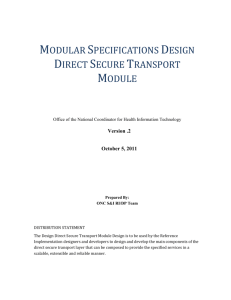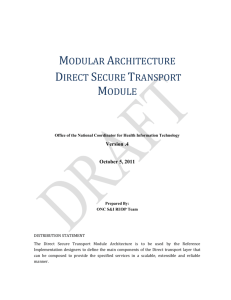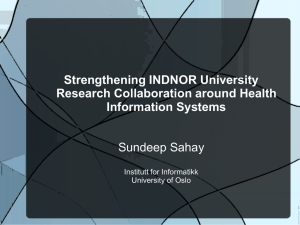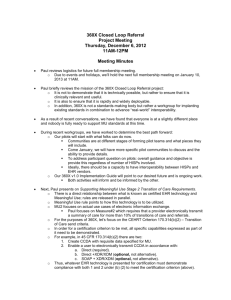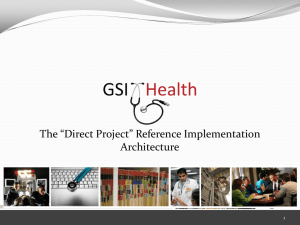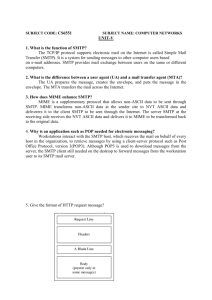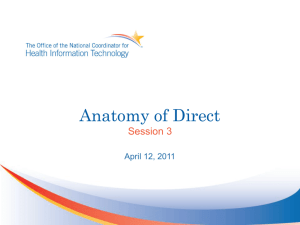DIRECT_Secure_Transport_Design_v_1_0
advertisement
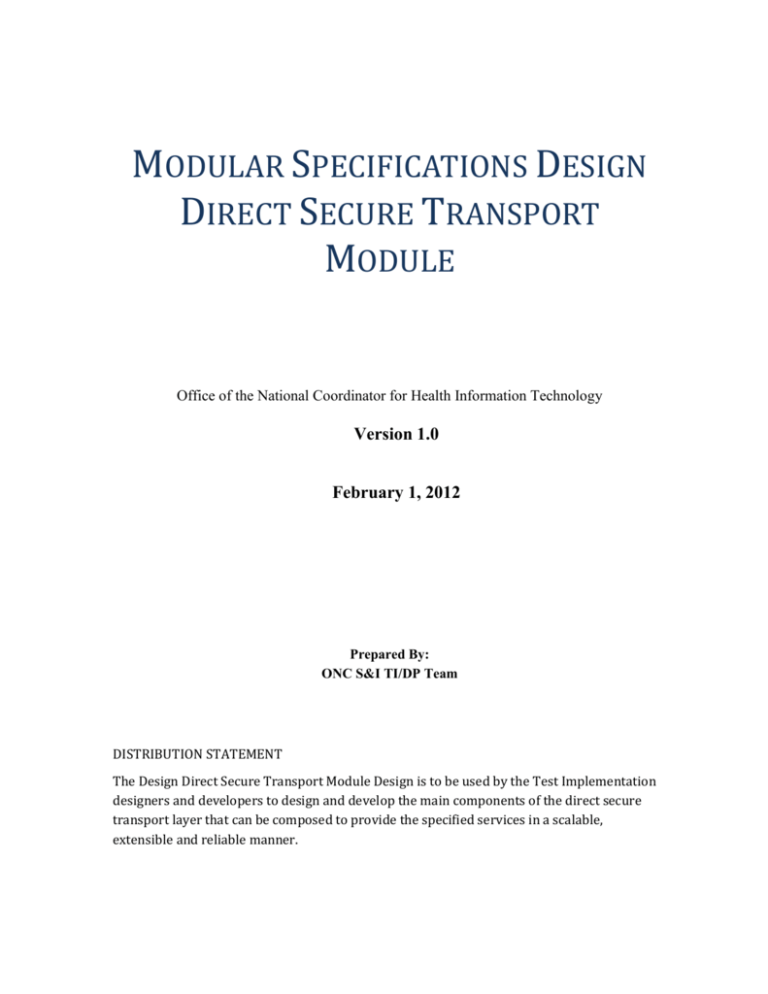
MODULAR SPECIFICATIONS DESIGN DIRECT SECURE TRANSPORT MODULE Office of the National Coordinator for Health Information Technology Version 1.0 February 1, 2012 Prepared By: ONC S&I TI/DP Team DISTRIBUTION STATEMENT The Design Direct Secure Transport Module Design is to be used by the Test Implementation designers and developers to design and develop the main components of the direct secure transport layer that can be composed to provide the specified services in a scalable, extensible and reliable manner. DOCUMENT CHANGE HISTORY Version .1 .2 1.0 Date 09/16/2011 10/05/2011 2/1/2012 Changed By Lockheed Martin Lockheed Martin Lockheed Martin Items Changed Since Previous Version First Draft Comments changes Public comments TABLE OF CONTENTS 1.0 OBJECTIVE/PURPOSE .........................................................................................................................1 2.0 REQUIREMENTS/GOALS .....................................................................................................................1 3.0 CONSTRAINTS AND ASSUMPTIONS .............................................................................................1 3.1 CONSTRAINTS ........................................................................................................................................... 1 3,2 ASSUMPTIONS .......................................................................................................................................... 2 4.0 DEPENDENCIES ...................................................................................................................................2 5.0 ARCHITECTURE ...................................................................................................................................3 5.1 DESIGN DIAGRAMS ............................................................................................................................ 3 5.2 SEQUENCE DIAGRAMS ........................................................................................................................ 4 5.2.1 Sequence Diagram Steps .......................................................................................................... 4 5.2.2 Sequence Diagram Steps- XDR ................................................................................................. 5 5.3 INTERFACES ........................................................................................ ERROR! BOOKMARK NOT DEFINED. 6.0 REFERENCES .......................................................................................................................................5 LIST OF FIGURES FIGURE 1. PACKAGE DIAGRAM ..................................................................................... ERROR! BOOKMARK NOT DEFINED. FIGURE 2. DESIGN MODEL ........................................................................................................................................ 3 FIGURE 4. FULL SERVICE HISP XDR DESIGN MODEL SEQUENCE DIAGRAM......................................................................... 5 1.0 OBJECTIVE/PURPOSE This document provides a high-level design of the Test Implementation (TI) Direct Secure Transport Module Core components. These components are used to send email securely between a TI DIRECT email server and other Simple Mail Transfer Protocol (SMTP) mail servers. 2.0 REQUIREMENTS/GOALS The goals of the Direct Secure Transport Module Core design are to: Provide a design to address the functional requirements of Direct Secure Transport Module. Identify and define components for non-overlapping functionalities of Direct Secure Transport Module. Code to interfaces, not implementations. Promote code reuse. Achieve ease of integration. Be extensible. Couple loosely with other components. Achieve ease of Unit testing and Integration testing. 3.0 CONSTRAINTS AND ASSUMPTIONS 3.1 CONSTRAINTS The Direct Secure Transport Module is based on SMTP. The following constraints are made on the Direct Secure Transport Module: Use Cross-Enterprise Document Media Interchange (XDM) - provides document interchange using a common file and directory structure over several standard media. This permits the patient to use physical media to carry medical documents. This also permits the use of person-to-person email to convey medical documents. Use Cross-Enterprise Document Reliable Interchange (XDR) - provides document interchange using a reliable messaging system. This permits direct document interchange between EHRs, PHRs, and other healthcare IT systems in the absence of a document sharing infrastructure such as XDS Registry and Repositories. Use Secure/Multipurpose Internet Mail Extensions (S/MIME) - which is a standard for public key encryption and signing of MIME data. S/MIME provides the following cryptographic security services for electronic messaging applications: authentication, message integrity, non-repudiation of origin, privacy and data security. 11 Be platform neutral – DIRECT uses standards that can be implemented using many operating systems and programming languages. 3,2 ASSUMPTIONS The Direct Project allows secure communication of health data between health care participants who already know and trust each other and thus are bound by a set of simplifying assumptions. The Direct Project assumes that the sender is responsible for enforcement of minimal requirements before sending data, including the collection of patient consent, where appropriate. These requirements may or may not be handled electronically, but they are handled nonetheless, even when sharing information via paper or fax. For example, a sender may call to ask whether a fax was sent to the correct fax number and was received by the intended receiver. This is sometimes referred to as “out of band” verification. Policy enforcement for Direct Project is out of scope for TI The Sender of a Direct message has determined that it is legally appropriate to send the information to the Receiver through out-of-band means: o The Sender has determined that the Receiver’s address is correct. o The Sender has communicated to the receiver, perhaps out-of-band, the purpose for exchanging the information. o The Sender and Receiver do not require common or pre-negotiated patient identifiers. Similar to the exchange of fax or paper documents, there is no expectation that a received message will be automatically matched to a patient or automatically filed in an EHR. Multiple types of content, from unstructured (text, PDF, etc.) to semi-structured (various CDA templates, HL7 MDM, etc.) to fully structured (CCR, CCD) will be handled. X.509 certificates for DIRECT will be issued by a valid organization such as Verisign or Entrust, The certificate issuance and management of DIRECT is NOT mandated by the Office of the National Coordinator for Health Information Technology (ONC). 4.0 DEPENDENCIES The Direct Secure Transport core components will use DIRECT common components like logging and utilities. The DIRECT software will use the open source software Apache James as the Mail Enterprise Server which will support SMTP and POP3 mail transfer agent. The DIRECT software will use Apache Tomcat as the Web Server. 11 5.0 ARCHITECTURE The intent of this design is to identify and define the interfaces the Direct Secure Transport core exposes, the interfaces the Direct Secure Transport core uses, and to expand upon the high-level components defined in the Direct Secure Transport Module Architecture document 5.1 DESIGN DIAGRAMS The following diagram shows the packages where the DIRECT Secure Transport Core components reside and the dependencies with other packages of DIRECT. Figure 1. Design Model Spec Factory comment: This diagram does not have a description, it is unclear exactly what is being communicated, do the arrows imply dependencies, information flows etc? Arrows denote information flows. The Initiator HISP client can either send a simple email with attachment(s) or access a Web Service. Full service HISP takes care of all encryption and signing functions and sends the message to the Recipient HISP. There is an optional XDR to XDM conversion that takes place. At the Recipient HISP the process is reversed, the attachment is decrypted and signature is verified. The Recipient Client can either retrieve the message in MIME format via SMTP protocol or via the SOAP Web service. In both cases it is a “pull” type of process as reflected by the direction of information flows. 11 5.2 SEQUENCE DIAGRAMS The following diagram shows the sequence of operations that are performed using the Direct Secure Transport core components. Figure 2. Full Service HISP Design Model Sequence Diagram Spec Factory comment: The sequence diagrams seem aligned with the specification, a written description could be useful in future iterations. 5.2.1 SEQUENCE DIAGRAM STEPS 1. Address is discovered via DNS record 2. MIME message is sent via SMTP 11 3. Message is signed and encrypted (Note – detached signature is used as per RFC 5751) 4. Certificate of the Recipient is looked up via DNS record (as a Direct Address-bound or Organization-bound Certificate). Please note that the certificate trust processing, i.e. validation, revocation, etc. is implied in the Crypto module. 5. Reverse process takes place on the Recipient side: S/MIME message is decryptes, signature validated, and a signed MDN is returned from the recipient HISP. Figure 3. Full Service HISP XDR Design Model Sequence Diagram 5.2.2 SEQUENCE DIAGRAM STEPS- XDR 6.0 REFERENCES The following references were used to produce this document: 11 1. Direct Transport and Security Requirements Traceability Matrix. http://jira.siframework.org/wiki/display/MSP/Specifications+Team 2. Applicability Statement for Secure Health Transport http://wiki.directproject.org/Applicability+Statement+for+Secure+Health+Transport 3. XDR and XDM for Direct Messaging Specification http://wiki.directproject.org/XDR+and+XDM+for+Direct+Messaging 11
